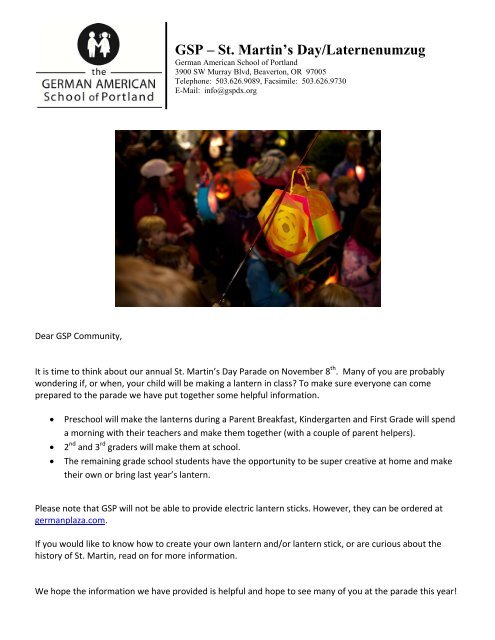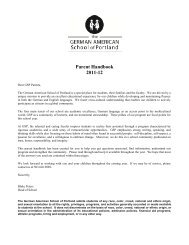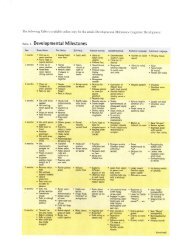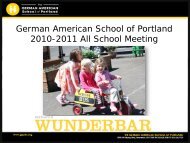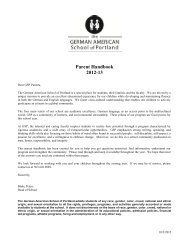St. Martin's Day/Laternenumzug - The German American School of ...
St. Martin's Day/Laternenumzug - The German American School of ...
St. Martin's Day/Laternenumzug - The German American School of ...
You also want an ePaper? Increase the reach of your titles
YUMPU automatically turns print PDFs into web optimized ePapers that Google loves.
GSP – <strong>St</strong>. Martin’s <strong>Day</strong>/<strong>Laternenumzug</strong><br />
<strong>German</strong> <strong>American</strong> <strong>School</strong> <strong>of</strong> Portland<br />
3900 SW Murray Blvd, Beaverton, OR 97005<br />
Telephone: 503.626.9089, Facsimile: 503.626.9730<br />
E-Mail: info@gspdx.org<br />
Dear GSP Community,<br />
It is time to think about our annual <strong>St</strong>. Martin’s <strong>Day</strong> Parade on November 8 th . Many <strong>of</strong> you are probably<br />
wondering if, or when, your child will be making a lantern in class To make sure everyone can come<br />
prepared to the parade we have put together some helpful information.<br />
<br />
<br />
<br />
Preschool will make the lanterns during a Parent Breakfast, Kindergarten and First Grade will spend<br />
a morning with their teachers and make them together (with a couple <strong>of</strong> parent helpers).<br />
2 nd and 3 rd graders will make them at school.<br />
<strong>The</strong> remaining grade school students have the opportunity to be super creative at home and make<br />
their own or bring last year’s lantern.<br />
Please note that GSP will not be able to provide electric lantern sticks. However, they can be ordered at<br />
germanplaza.com.<br />
If you would like to know how to create your own lantern and/or lantern stick, or are curious about the<br />
history <strong>of</strong> <strong>St</strong>. Martin, read on for more information.<br />
We hope the information we have provided is helpful and hope to see many <strong>of</strong> you at the parade this year!
Directions:<br />
Lantern made out <strong>of</strong> a balloon, tissue paper and<br />
wallpaper adhesive*<br />
‣ Blow up a balloon to the desired size, tie a secure knot.<br />
‣ Tear or cut lots <strong>of</strong> tissue paper <strong>of</strong> one, or different colors, into 1‐2 inch pieces.<br />
‣ Mix wallpaper adhesive, (following their directions) and apply to a section on the<br />
balloon. <strong>St</strong>ick the paper pieces onto the clue and let the pieces overlap. Smooth out<br />
around the edges with more glue. Apply tissue paper in more sections all the way<br />
around the balloon, but leave about 2 inches around the knot. To avoid the balloon<br />
from rolling around, you may place it into a bowl while working. After the first layer is<br />
completed, let it dry for several hours. Repeat with three to four more layers, and let<br />
dry completely. Pop the balloon and cut the edge evenly all the way around.<br />
‣ Poke a hole on each side <strong>of</strong> lantern to affix a wire hanger where you can later attach<br />
the lantern stick.<br />
*As an alternative to using wall paper adhesive for this project, you may dilute white Elmer’s glue with water and follow<br />
the directions above.<br />
You can also find other techniques and styles <strong>of</strong> lanterns at<br />
http://kidscrafts.suite101.com/article.cfm/how_to_make_a_lantern.<br />
Link provided with permission from the author.
Lantern <strong>St</strong>icks<br />
Materials‐<br />
1 wooden dowel 2’ long (hardware store)<br />
1 foot <strong>of</strong> cord or heavy string<br />
1 light stick or very tiny flashlight (Party City or marine store)<br />
Drill to make a hole in dowel, if desired<br />
<strong>St</strong>ep 1‐If you are handy with power tools, drill a hole large enough for the cord to<br />
pass through in the end <strong>of</strong> the dowel. Be careful not to split the dowel!<br />
Otherwise, you can just tie the cord around one end <strong>of</strong> the dowel, and maybe<br />
add a little duct tape on top to avoid it slipping.<br />
<strong>St</strong>ep 2‐To the other end <strong>of</strong> the cord, attach your glow stick or flashlight. Some<br />
glow sticks have a hole to hang from a cord, so do some little flashlights. Once<br />
your child brings home their lantern, you can adjust the length <strong>of</strong> the cord so that<br />
the light is inside the lantern when the lantern hangs over the end <strong>of</strong> the pole.<br />
<strong>St</strong>ep 3‐You may want to use a little tape to attach the lantern more securely on<br />
the pole so it doesn’t slide up and down, or you can also tie it on.
<strong>St</strong>. <strong>Martin's</strong> <strong>Day</strong><br />
Every year on November 11, <strong>German</strong> children celebrate <strong>St</strong> <strong>Martin's</strong> <strong>Day</strong> as the start <strong>of</strong> Carnival season. In<br />
many regions children walk through the streets singing special songs. Sometimes they perform a little play<br />
with a very specific piece <strong>of</strong> Martin’s life. It is the story about how he meets a beggar on a cold night and,<br />
because he feels sorry for him, cuts his cloak in half to share it with the beggar. That is the legend <strong>of</strong> <strong>St</strong>.<br />
Martin, but who was he really<br />
<strong>St</strong>. Martin the Roman Soldier Martin was born in 316 a.d. as the son <strong>of</strong> a Roman Officer in what is now<br />
Hungary. He was raised in Pavia, Italy where he joined the army at age 15 as a soldier and later became an<br />
<strong>of</strong>ficer. Even during his military career he was known as a very compassionate man. When, on a cold<br />
winter’s day, he encountered a freezing beggar, he took his sword, split his wide cloak in two and gave the<br />
beggar half. <strong>The</strong> following night he had a dream where the beggar revealed himself as Jesus Christ. After<br />
this experience he decided to get baptized, left the military service and went to seek the Bishop Hilarus in<br />
the French town <strong>of</strong> Poitiers, who became his teacher.<br />
<strong>St</strong>. Martin – <strong>The</strong> Bishop Because Martin was so compassionate, he was very popular with the people.<br />
<strong>The</strong>y begged him to become Bishop <strong>of</strong> the town <strong>of</strong> Tours. A legend tells the story <strong>of</strong> Martin feeling<br />
unworthy <strong>of</strong> that honor and hiding out in a goose stall. However, the geese made so much noise that<br />
Martin was found – and as punishment Martin had the geese slaughtered and cooked. That is perhaps the<br />
reason that in some regions people eat a “Martinsgans” “Martinsgoose” on November 11 th . Martin<br />
eventually became Bishop and remained so for nearly 30 years. During that time it is said he healed the sick<br />
and performed numerous miracles. When he died at the age <strong>of</strong> almost 80, people came from near and far<br />
to attend his funeral – Martin had become famous.<br />
<strong>St</strong>. Martin – <strong>The</strong> Saint Martin was bestowed sainthood by the pope and is now the Patron Saint <strong>of</strong> many<br />
vocations. For vintners, barrel makers, farriers, weavers, Tailors, shepherds, hat makers and mill workers. In<br />
addition he also protects beggars and soldiers – and all pets. But why do you walk around with a lantern on<br />
<strong>St</strong>. Martin’s <strong>Day</strong> <strong>The</strong>re could be two reasons:<br />
First: Often people held candle light vigils at Martin’s grave, which could have developed into Lantern<br />
parades. Another origin <strong>of</strong> the Lantern tradition could be rooted in the yearly routine <strong>of</strong> farmers: For<br />
people around Martini, around November 11 th , light and fire became more important again. It got dark very<br />
early and the wood stoves were put back into service. In addition, farmers finished tending to their fields in<br />
the beginning <strong>of</strong> November. As thanks for the harvest, fires were lit on the fields after harvest time.<br />
Children made torches out <strong>of</strong> straw and paper, or “Trullichter”, which were hollowed out gourds and<br />
pumpkins. <strong>The</strong>n they made their way through town, asking neighbors for fruit and pastries. That is how the<br />
modern day Lantern parade could have developed.<br />
<strong>The</strong> Songs <strong>The</strong>re are many songs that the children sing; here is one, with an English translation:<br />
Ich geh' mit meiner Laterne<br />
Und meine Laterne mit mir.<br />
Dort oben leuchten die <strong>St</strong>erne,<br />
Hier unten, da leuchten wir.<br />
(Mein Licht ist aus,<br />
Wir gehn nach Haus,<br />
Rabimmel, rabammel, rabum.)<br />
I'm walking with my lantern<br />
And my lantern goes with me.<br />
Above the stars are shining,<br />
and we are shining below.<br />
(My light has gone out,<br />
We're going home,<br />
rabimmel, rabammel, rabum)
<strong>St</strong>. Martin ‐ wer war das<br />
Jedes Jahr am 11. November gibt es einen Gedenktag für einen ganz bestimmten Heiligen: Für Sankt Martin.<br />
In vielen Gegenden ziehen Kinder mit Laternen durch die <strong>St</strong>raßen und singen Martinslieder. Manche führen<br />
ein kleines <strong>The</strong>aterstück auf, mit einer ganz bestimmten Szene aus Martins Leben. Es ist die Geschichte, als<br />
er in einer kalten Nacht einem Bettler begegnet und ihm aus Mitleid ein <strong>St</strong>ück von seinem Mantel<br />
abschneidet. Diese Geschichte kennen wir alle. Aber wer war dieser Martin eigentlich Und wie ist er ein so<br />
berühmter Heiliger geworden<br />
<strong>St</strong>. Martin – der römische Soldat Martin wurde im Jahr 316 n. Chr. als Sohn eines römischen Offiziers in<br />
Pannonien ‐ im heutigen Ungarn ‐ geboren. Aufgewachsen ist er in Pavia in Italien. Mit fünfzehn Jahren ging<br />
er zur Armee und wurde Soldat, und bald darauf Offizier. Schon während seiner gesamten Armeezeit war<br />
Martin ein sehr hilfsbereiter Mensch. Als er an einem kalten Wintertag an einem hungernden und frierenden<br />
Bettler vorbeiritt, teilte er seinen weiten Mantel mit seinem Schwert und schenkte dem Bettler die eine<br />
Hälfte. In der folgenden Nacht erschien ihm der Bettler im Traum und gab sich als Jesus Christus zu<br />
erkennen! Nach diesem Erlebnis ließ Martin sich taufen. Er verließ den Militärdienst und ging in die<br />
französische <strong>St</strong>adt Poitiers zu Bisch<strong>of</strong> Hilarius, der sein Lehrer wurde.<br />
<strong>St</strong> Martin – der Bisch<strong>of</strong>f Da Martin so ein hilfsbereiter Mensch war, wurde er bei der Bevölkerung sehr<br />
beliebt. Die Leute baten ihn, Bisch<strong>of</strong> der <strong>St</strong>adt Tours zu werden. Eine Legende erzählt davon, daß Martin sich<br />
dazu nicht würdig genug fühlte und sich in einem Gänsestall vor dem Volk versteckte. Die Gänse in diesem<br />
<strong>St</strong>all schnatterten aber so laut, daß sie Martin verrieten – und zur <strong>St</strong>rafe ließ Martin sie dann braten. Daher<br />
kommt vielleicht auch der Brauch, daß man am 11. November in manchen Gegenden eine Martinsgans isst.<br />
Martin wurde schließlich doch noch Bisch<strong>of</strong> und blieb fast 30 Jahre im Amt. In dieser Zeit hat er angeblich<br />
zahlreiche Wundertaten und Heilungen vollbracht. Als er mit fast 80 Jahren starb, kamen die Leute von nah<br />
und fern zu seiner Beerdigung – denn Martin war sehr berühmt geworden.<br />
<strong>St</strong>. Martin – der Heilige Martin wurde vom Papst heiliggesprochen und ist nun der Schutzpatron für viele<br />
Berufe. Für Winzer, Fassmacher, Huf‐ und Waffenschmiede, Weber, Schneider, Bürstenbinder, Gerber,<br />
Hirten, Hutmacher und Müller. Er beschützt außerdem die Bettler und die Soldaten – und alle Hautiere. Aber<br />
warum geht man am Sankt‐Martins‐Tag mit einer Laterne spazieren Dafür kann es zwei Gründe geben:<br />
Erstens: die Leute haben am Grab des heiligen Martin sehr <strong>of</strong>t Lichterprozessionen gemacht – daraus<br />
könnten sich die Laternenumzüge entwickelt haben.<br />
Eine andere Wurzel des Laternenbrauchs könnte im Jahresablauf der Bauern liegen: Um Martini, also um<br />
den 11. November herum, wurde das Licht und das Feuer für die Menschen wieder wichtiger. Es wurde<br />
wieder sehr früh dunkel und man hat zum ersten Mal den Ofen eingeheizt. Außerdem haben die Bauern<br />
Anfang November die Arbeit auf den Feldern beendet. Zum Dank für die Ernte hat man auf den<br />
abgeernteten Feldern Feuer entzündet. Die Kinder haben an dem Feuer Fackeln aus <strong>St</strong>roh und Papier<br />
entzündet, oder sogenannte "Trullichter", das waren ausgehöhlte Rüben und Kürbisse. Mit diesen Lichtern<br />
sind sie dann durch die Orte gezogen, um Obst und Gebäck zu erbetteln. Daraus könnten sich unsere<br />
heutigen Laternenumzüge entwickelt haben.


